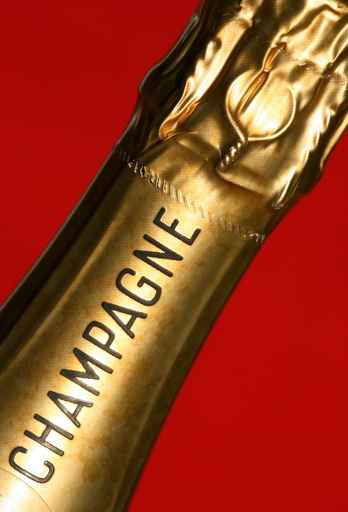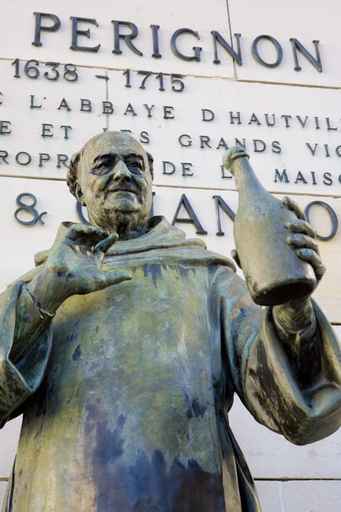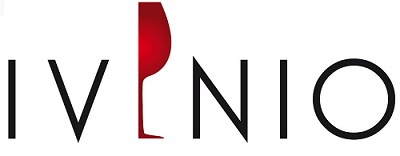Champagne is the party drink # 1 opened up to celebrate something or for festive occasions. If it concerns a party, a New Year’s celebration or a wedding it’s the same thing; Champagne will be on hand! The demand for Champagne around the world has risen dramatically over the past 20 years and only exports currently represent a value of almost € 2.5 billion Continuing this trend, we will in the near future meet supply problems since the production of Champagne is limited to just the size of the Champagne district. Champagne can not be manufactured elsewhere than just in the Champagne wine region and the region can’t of course by logic not become bigger just because that the demand increases.
Historically, wine has been produced in the Champagne wine region since the Roman times. First white wine, later red to finally become “grey” – “gris” which means that red grapes are used to produce, more or less, white wine. The grape peel is separated rather immediately from the grape juice since it’s the peel of the grape that secretes the red color . It was probably in England, in the early 1700s that they invented the idea of losing sparkling wine in the bottle. Before that, the wine came in barrels that had the bad property of often “bubble over”. Being able to seal the bottles gave the opportunity to maintain the carbon dioxide in the wine, and this was how the bottled sparkling wine was created. Ironically, what we call “Champagne Method” is not from the Champagne region. The legend says that it was a monk at the familiar name of “Dom Perignon” that brought this method back home from a trip to southern France. “The Champagne method” was namely used already before, for the production of the sparkling wines of Limoux in the Languedoc.
 It is actually considered to be here that the Champagne method was invented, or what we call the traditional method for making sparkling wine. Even today, Limoux produces tasty and affordable “Blanquette de Limoux”, but that’s another story. Dom Perignon is considered the organizer of the Champagne production in an almost scientific manner. He defined how to produce and which wine grape varieties that should be used. Then it went quickly. It is considered that the very first champagne winery is the well known Ruinart followed up by Moët, Clicquot, Roederer, Heidsieck et Cie. Now, is Champagne a method or a wine? Actually both, but it’s just the wine that is unique from Champagne. The method in which the carbonic acid is produced naturally by implementing two fermentation processes of the wine is used in both Italy and Spain. Then the method is often called “Metodo classico” in Italy and “Metodo Tradicional” in Spain. Much of today’s winegrowers in Champagne are actually grape growers and not wine makers. It is considered to be roughly 13,000 who grow grapes and then sell all or a portion of their harvest to the great wine houses. It is then the winery that produces and sells the finished champagne.
It is actually considered to be here that the Champagne method was invented, or what we call the traditional method for making sparkling wine. Even today, Limoux produces tasty and affordable “Blanquette de Limoux”, but that’s another story. Dom Perignon is considered the organizer of the Champagne production in an almost scientific manner. He defined how to produce and which wine grape varieties that should be used. Then it went quickly. It is considered that the very first champagne winery is the well known Ruinart followed up by Moët, Clicquot, Roederer, Heidsieck et Cie. Now, is Champagne a method or a wine? Actually both, but it’s just the wine that is unique from Champagne. The method in which the carbonic acid is produced naturally by implementing two fermentation processes of the wine is used in both Italy and Spain. Then the method is often called “Metodo classico” in Italy and “Metodo Tradicional” in Spain. Much of today’s winegrowers in Champagne are actually grape growers and not wine makers. It is considered to be roughly 13,000 who grow grapes and then sell all or a portion of their harvest to the great wine houses. It is then the winery that produces and sells the finished champagne.
 It is these great wine houses, often owned by multinational companies, which due to its size is offered in export markets. But there are also smaller vintners that produce very good Champagnes. Unfortunately, they are often not exported outside France. The classification of Champagne is relatively easy to understand. All Champagnes are manufactured in the same manner. It is only the raw material, ie, the quality of the grapes that divides the champagnes into three different categories. Some villages are considered to have better quality of their grapes and can therefore charge a higher price per kilo on their grapes. Champagne: it is the generic category for sparkling wine made according to the traditional method of grapes from Champagne. The grapes come from villages which represent 68% of the total Champagne wine region. Champagne Premier Cru: this wine is made from grapes that come from villages that are considered to produce grapes of slightly higher quality. These villages represent 18% of the arable land in Champagne. Champagne Grand Cru: this is champagne made from grapes from the very best ranked villages. They represent only 14% of the arable land in the Champagne appellation.
It is these great wine houses, often owned by multinational companies, which due to its size is offered in export markets. But there are also smaller vintners that produce very good Champagnes. Unfortunately, they are often not exported outside France. The classification of Champagne is relatively easy to understand. All Champagnes are manufactured in the same manner. It is only the raw material, ie, the quality of the grapes that divides the champagnes into three different categories. Some villages are considered to have better quality of their grapes and can therefore charge a higher price per kilo on their grapes. Champagne: it is the generic category for sparkling wine made according to the traditional method of grapes from Champagne. The grapes come from villages which represent 68% of the total Champagne wine region. Champagne Premier Cru: this wine is made from grapes that come from villages that are considered to produce grapes of slightly higher quality. These villages represent 18% of the arable land in Champagne. Champagne Grand Cru: this is champagne made from grapes from the very best ranked villages. They represent only 14% of the arable land in the Champagne appellation.

If the grape’s origin is the basic principle of classifying the Champagne, there are also other parameters that affect the taste and quality:
- The press of the grapes: the quality of the juice is reduced the more one presses. The rule says that out of 4000 kg of grapes, only 25.5 hL can be extracted. More juice can be extracted, but it is not used for Champagne but is sent to distilleries for other usage.
- The mixture of the finished wine: the wine responsible person has a great responsibility in the Champagne wine region since the finished wine is “mixed” and is not merely the result of one year’s harvest. One can thus completely legally mix several different vintages of the same wine. This is of course only the case for “non-millesime” wines, where the vintage is not mentioned. The wine can also be mixed depending on if it’s the first press or the subsequent presses. These methods are how the flavor of the particular champagne can be stabilized one year after another and ensure that the consumer is offered more or less the same flavor regardless of the vintage. This is why the choice of Champagne, unlike other wines, becomes a matter of brand preference rather than a specific product and a specific vintage.
- The wine storage:after launching the second fermentation of the wine which is actually the process which produces the carbonic acid in the wine, the wine must be aged for at least one year. The finer champagnes however are stored another 2-3 years. The wine matures this way and obtain smaller and finer bubbles contributing to a more harmonious and balanced flavor.


